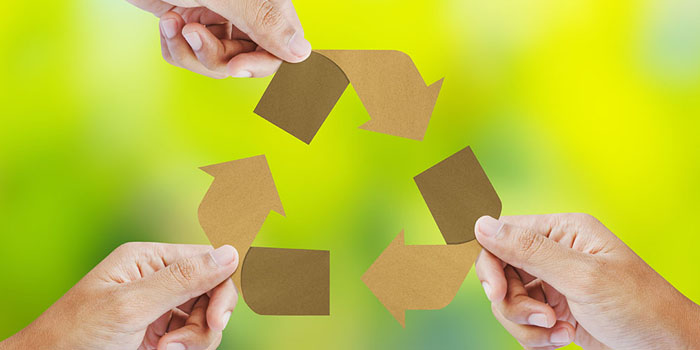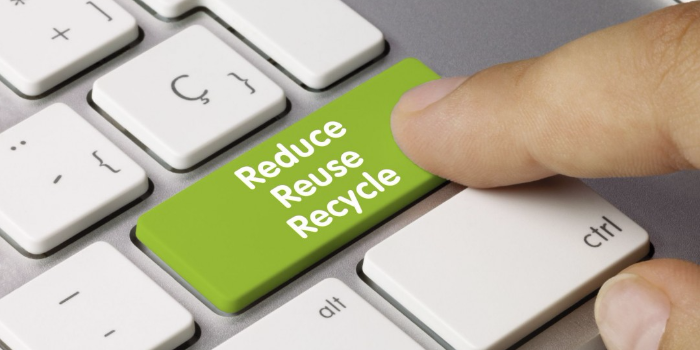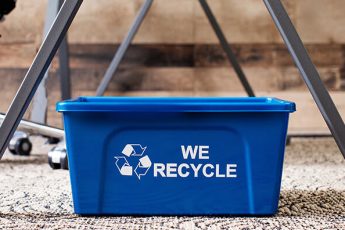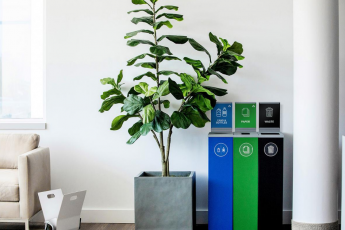The Past – We’ve Come a Long Way!

Recycling has come a long way over the past few decades – in the US there wasn’t a single recycling program in place until 1973 (in The Hidden Past of Recycling you’ll read that the concept of recycling was widely used in the past, however only privately or individually). Now, there are over 8,000 programs in operation. The first ever curbside recycling program in Canada began in 1973, the program initially served 80,000 homes in the Toronto area and eventually curbside programs and recycling centres were all over the country.
While we’ve come a long way since the explosion of the environmental movement in the 1970s, our recycling programs still have a long way to go as a collective group. Keep reading and you’ll see how we currently reduce our waste today and how we can improve our recycling habits in the future.
![]()
The Present – Strategies for Zero Waste

Currently the US recycles about one third of the municipal trash (waste generated in homes, schools and non-industrial businesses) and Canada recycles about 21 percent of what would otherwise end up in the solid waste stream. Here are some strategies you can do today that will immediately increase how much you recycle:
![]()
Closing the Recycling Loop
Separating your trash from your recyclables is only one step in the recycling loop – in order to close the gap, manufacturers need to start making more products out of recycled material and consumers need to focus on buying these products. Creating merchandise from scratch is often very harsh and damaging to the environment, the more life that we can get out of a product made from post-consumer recycled content, the better!
![]()
Compost, Compost, Compost!
The amount of organic waste that ends up in landfill or burned in an incinerator is a little alarming – 60 percent of household waste in the US is compostable but only 8 percent of Americans compost. Canada has done a fairly good job on the composting front – as of 2011, over half of Canadian households (61%) had participated in some form of composting. If you have a green thumb, composting is the way to go – you’ll never have a better looking garden in the summer!
And if you’re an enthusiastic early adapter to up-and-coming composting trends, be sure to take a look at The Humanure System, which you can guess from the name, involves recycling your poop—and no, it’s obviously not for everyone…
![]()
Keep the Garbage Bucket as Empty as Possible
Recycling and composting are great ways to keep what’s going in the garbage to a minimum, but there are more ways to stem the garbage cans’ burly appetite. Pre-Cycling is a great way to reduce how much trash your house is sending to the curb – buying in bulk to reduce packaging, using reusable bags, having a refillable water bottle or coffee mug – these are just a few examples of how you can pre-cycle..
![]()
The Future – Strategies to Boost Recycling Rates
While recycling has increased in North America, the amount of trash produced has increased as well. The amount of material recycled today equals the total amount of trash produced in 1960. While recycling programs are a continuing success, experts say in future we should focus on limiting the amount of trash we produce to begin with, doing so will help lower the amount of greenhouse gasses being released into the air.
![]()
Updated and Expended Bottle Bills
Having a bottle bill in place is a very effective way to get people recycling. A bottle bill (or container deposit law), requires a refundable deposit on beverage containers ensuring they are returned for recycling. Ideally, every state should have a container deposit law, but unfortunately only 10 states have a bottle bill in place – many of which don’t include plastic bottles. If more states could enact and expand these laws, the amount of plastics ending up in landfills would drop drastically.
![]()
Manage Electronic Waste
Technology is always changing, and with the explosion of smartphones, tablets and laptops over the past decade, it has meant an increase in the amount of electronic waste that is being produced. In 2011, the US generated 3.41 million tons of e-waste, of which only 850,000 tons were recycled – the rest ended up in landfills or incinerators, the toxic chemicals that electronic components are made from end up seeping into our soil or up in the atmosphere. Businesses that sell electronics are beginning to take responsibility for the amount of e-waste produced, offering trade in programs allowing them to recycle unwanted gadgets – some even give you some money back!
![]()
Stop Using Plastic Bags
This ties back to pre-cycling, but the numbers on how much plastic bags are thrown out versus how many are recycled warrant its own section – 380 billion plastic bags are used a year in the US alone and less than 5 percent are recycled! Plastic made with PET (polyethylene terephthalate, in case you were wondering why we needed an acronym for it) do not biodegrade, they do break down in UV light (photo-degradation), but that can take 10-100 years. That’s if exposed to sunlight, and since most garbage is buried at a landfill, the whole process takes even longer.
Currently, less than 1 percent of plastic bags are recycled each year. Recycling one ton of plastic bags costs $4,000—the recycled product can then be sold for only $32. We don’t claim to be the best mathematicians in the world, but we’re fairly confident we wouldn’t want to enter into the business of recycling plastic bags for profit.
Efforts are being done all over to get people to ditch the plastic bags, supermarkets offer reusable cloth bags and now charge you for plastic bags, and San Francisco has even flat out banned the distribution of plastic bags in the city. Fingers crossed that these measures are the beginning of the end of the dreaded plastic bag.
This should most certainly be enough information to get your started on your way to recycling stardom. Stay tuned and we’ll fill you in on the sensible, not-so-sensible and downright strange recycling trends that you’ll start to see in the coming years—including, of course, recycling your #1’s and 2’s.
![]()













